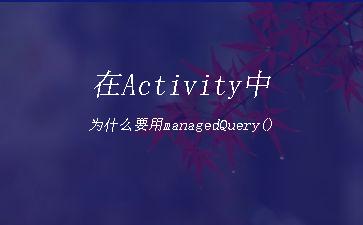刚開始接触android的时候,每次用数据库都会犹豫使用哪种方式,一种是getContentResolver().query(…),还有一种是managedQuery(…),后来习惯了使用前一种,后一种就被我遗忘了,可是在实际做项目时,有时数据库常常会报cursor not close的warning,有的cursor你能够手动关闭,可是有一些就不能够了,比方当前是个listActivity,他的adapter是个cursorAdapter,这里的cursor就不能关掉,当然你能够在onDestroy中做关闭的操作,可是我比較习惯把cursor定义为局部变量,不是全局可见的,这种话你就不能在onDestroy中关闭了。
后来就查看源代码,发现manageQuery能够为你维护这个cursor。在你退出activity时为你自己主动关闭,事实上他的原理也非常easy,看源代码:
Activity.java
private static final class ManagedCursor {
ManagedCursor(Cursor cursor) {
mCursor = cursor;
mReleased = false;
mUpdated = false;
}
private final Cursor mCursor;
private boolean mReleased;
private boolean mUpdated;
}
private final ArrayList<ManagedCursor> mManagedCursors =
new ArrayList<ManagedCursor>();
这里定义了一个Cursor队列,这个Cursor是被封装的。
以下是对这个队列的操作:
public final Cursor managedQuery(Uri uri,
String[] projection,
String selection,
String[] selectionArgs,
String sortOrder)
{
Cursor c = getContentResolver().query(uri, projection, selection, selectionArgs, sortOrder);
if (c != null) {
startManagingCursor(c);
}
return c;
}
//加入,注意要加锁
public void startManagingCursor(Cursor c) {
synchronized (mManagedCursors) {
mManagedCursors.add(new ManagedCursor(c));
}
}
//在这个activity结束的时候,会调用onDestroy,所以清理的工作应该在那里
protected void onDestroy() {
//省略。。。。
// close any cursors we are managing.
synchronized (mManagedCursors) {
int numCursors = mManagedCursors.size();
for (int i = 0; i < numCursors; i++) {
ManagedCursor c = mManagedCursors.get(i);
if (c != null) {
c.mCursor.close();
}
}
mManagedCursors.clear();
}
//省略。。。。
}
近期又看源代码,发现能够不用managedQuery,能够用普通的query,然后执行 startManagingCursor(cursor),相同能够把cursor交给系统去管理,不用操心cursor没有close的情况了。
今天的文章在Activity中为什么要用managedQuery()分享到此就结束了,感谢您的阅读,如果确实帮到您,您可以动动手指转发给其他人。
版权声明:本文内容由互联网用户自发贡献,该文观点仅代表作者本人。本站仅提供信息存储空间服务,不拥有所有权,不承担相关法律责任。如发现本站有涉嫌侵权/违法违规的内容, 请发送邮件至 举报,一经查实,本站将立刻删除。
如需转载请保留出处:https://bianchenghao.cn/30182.html

